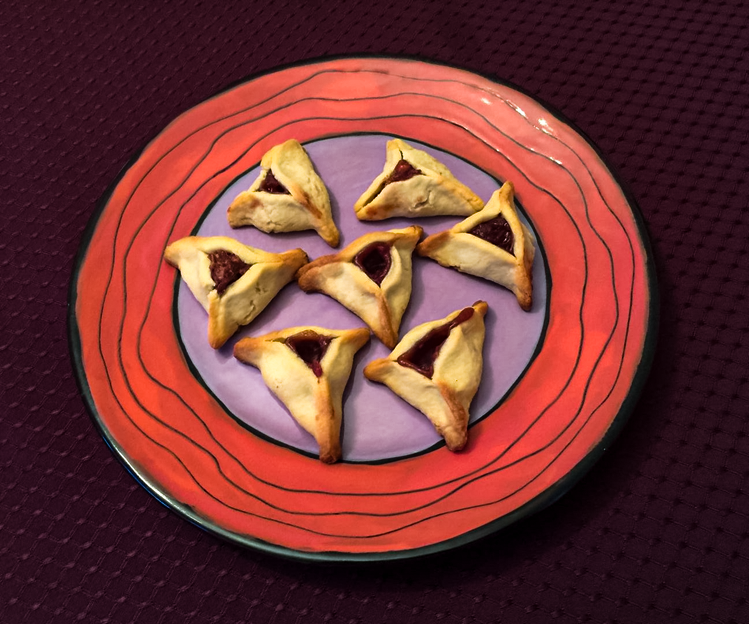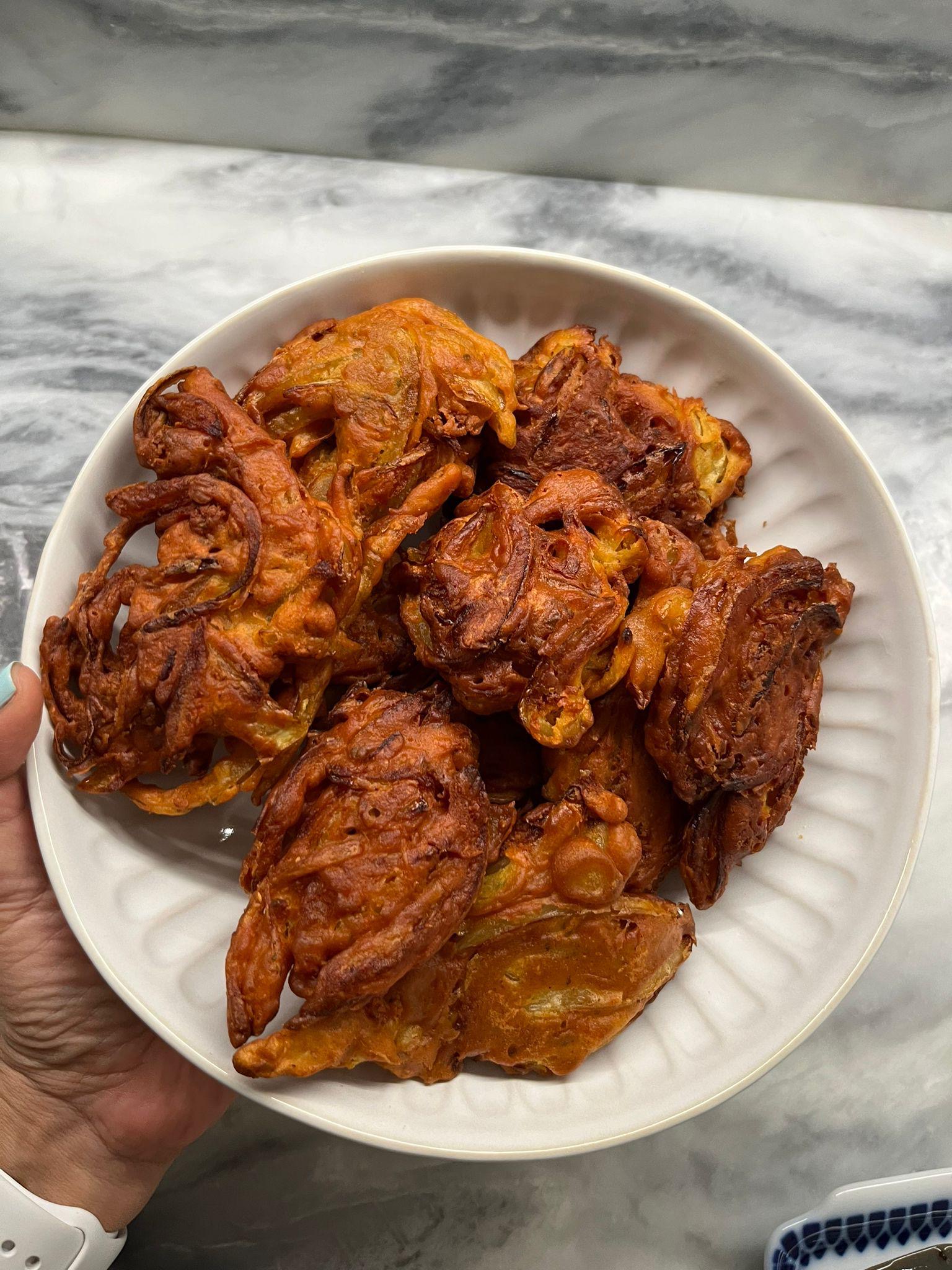A few years ago, my mother’s good friend Elizabeth asked her for a hamantaschen recipe. This sent my mother down a rabbit-hole in search of the perfect hamantaschen. The quest lasted for several months. She tried many different approaches to the dough and resurrected old family recipes for filling. She searched out new recipes for filling in cookbooks and on the internet. She mobilized the extended family as tasters. I ate more hamantaschen than I normally would. I’m not usually a hamantaschen fan and in fact, I am normally not much of a dessert baker. But I am always supportive of my mother’s efforts.

The Meyer-Fong Family (counter clock-wise from lower left–Yueh-Kam Fong, Ming-Yuen Meyer-Fong, Sheila Meyer, Roger Meyer, Saul Meyer-Fong, Tobie Meyer-Fong)
Mine is a family rich in food-related heritage. We all love to eat; many of us love to cook and experiment. My husband Ming-Yuen bakes pies, smokes lox in a wok, and is known around town for his Peking Duck and smoked brisket. My cooking tends to be more improvisational; I make Chinese food for everyday eating and years ago switched the cuisine of the extended family Seder from Ashkenazi to Sephardic. Decades ago, my mother’s mother was the cooking columnist for the Western Canada Jewish News; her poppy seed filled hamantaschen provided the subject for one of her columns (as did a maraschino cherry version!). My husband’s grandfather worked as a cook in Chinese restaurants in New York City, including one on the Upper West Side called Shanghai d’Or which earned a brief review in the New York Times in the 1960s. Both of our mothers are excellent cooks who greatly enjoy each other’s cooking. My mom always makes banana bread for my mother-in-law when she’s in town. My mother-in-law makes Chinese vegetarian feasts for my parents. Years ago, Mom Meyer and Mom Fong shared an afternoon making matzoh balls. Mom Fong immediately had ideas for how to make “enhanced matzoh balls” with scallions, shitake mushrooms, and carrots. She went home to Queens with a box of matzoh meal and made “enhanced vegetarian” matzoh balls for the monks at her Buddhist temple.
My mother’s hamantaschen experiments yielded important results. After many batches over several months, she decided that she didn’t like her mother’s dough recipe nearly as well as she liked Rosie’s. My cousin’s partner resurrected my grandmother’s maraschino cherry recipe; my mother preferred apricot jam or poppyseed. To be honest, I didn’t like any of them as much as I wanted to. I suggested a Chinese-inspired alternative to the traditional flavors. I had a small can of red beans and a vacuum pack of roasted chestnuts in my cupboard.
Sweet red beans are commonly used as a filling, topping, or base for desserts in both China and Japan. I like the beanish-texture of the canned varieties sold in the United States under Japanese or Japanese-sounding brand names better than the more typically Chinese thick, sandy, smooth sweet bean paste. Because of this, I generally prefer the canned Japanese-style red beans to fill Chinese buns, rice balls (tangyuan), and deep-fried pumpkin dumplings. They can also be used in Chinese-style red bean soups (with rice balls) or as a topping on big bowls of shaved ice, popular in China, Japan, Korea, and Taiwan. These hamantaschen were a delicious revelation. And–added bonus: the red bean and chestnut filling could hardly be easier to make!
Rosie’s Hamantaschen Dough
This is my mother’s slightly adapted version of the hamantaschen recipe in Rosie’s baking book. She spent months testing hamantaschen recipes and settled on this one for her “A-List Recipe Collection”. She says that it is better than my grandmother’s recipe. I was happy to be one of the official tasters for her hamantaschen perfection project!
The original, which calls for a poppyseed filling, comes from Rosie’s Bakery Chocolate-Packed, Jam-Filled, Butter-Rich, No-Holds-Barred Cookie Book (1996).
Ingredients:
- 2 cups plus 3 Tablespoons all-purpose flour
- 1/2 cup sugar
- 1/8 teaspoon baking powder
- 1 teaspoon grated orange zest
- ½ tsp salt
- 1 1/2 sticks unsalted butter at room temp, cut into 12 pieces)
- 2 Tablespoons ice water
- 2 large egg yolks
Method:
- Place flour, sugar baking powder, zest and salt in food processor and process for 20 seconds (you can do this with a fork or a whisk if you don’t feel like using a food processor).
- Distribute the butter evenly over the flour and process until the mixture resembles coarse meal, 15-20 seconds. (you also can do this with your fingers or pastry blender).
- In a small cup, whisk together the cold water and egg yolks. With the processor running, pour the egg mixture in a steady stream through the feed tube and process just until the dough comes together, 20-30 seconds. (or sprinkle the egg mixture over the flour mixture while tossing with a fork)
- Place the dough on a lightly floured work surface and knead it several times to bring it together
- Shape the dough into two thick disks, wrap each one in plastic wrap and refrigerate them for 1 hour. While the dough refrigerates, prepare the filling below (it takes about 3 minutes—including opening the can!)
- Line several baking sheets with parchment paper, or grease them lightly with vegetable oil.
- Remove one disk from the refrigerator and roll it out to form a round approximately 12 inches in diameter and a generous 1/8 inch thick.
- Using a 2 1/2” cookie cutter, cut out as many rounds as possible. Place them ¼ inch apart on the prepared baking sheets. Repeat with the second disk. (If you don’t have a 2 1/2” round cookie cutter you might have a glass that is about that size)
- Place 1 rounded teaspoon of red bean filling in the center of each round. Then fold the edges of the dough toward the center to form a triangle, leaving a bit of the filling showing in the center. Pinch the edges in three places to seal then. Place the baking sheets in the refrigerator for 30 minutes or the freezer for 15 minutes, to chill the triangles.
- Fifteen minutes before baking, preheat the oven to 375*F
- Bake the hamantaschen until they are crisp, firm to the touch and golden around the edges, i.e. for about 20 minutes. Let them cool completely on the baking sheets.
- Can leave them out on first day uncovered at room temp. After that store in airtight container with waxed paper between the layers. You can refrigerate for up to 3 days or freeze and eat later!).
Meyer-Fong Red Bean and Chestnut Filling:
- 1 small can of (canned) sweet red bean paste (Japanese: “an”)—for example “Ogura an”
- 3 roasted chestnuts from vacuum pack (optional)
Pour red beans from can into a small bowl. Use a fork to mash the 3 roasted chestnuts into the beans. The chestnuts add texture and density to the filling—but the flavor is excellent even with just the red beans.








